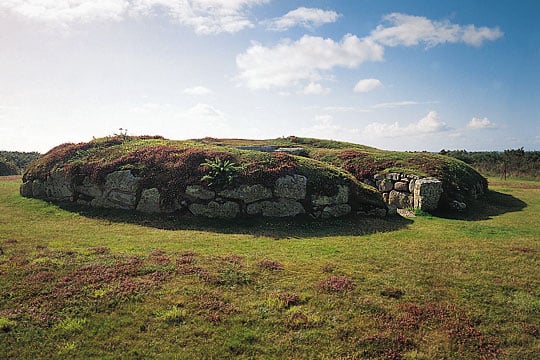History of Porth Hellick Down Burial Chamber
This is one of the largest and best preserved of the distinctive burial chambers known as entrance graves, found only on the Isles of Scilly and in the far west of Cornwall.

Dating from about 1500 BC, Porth Hellick is the largest entrance grave in a scattered cemetery that includes six others, and two low cairns.
At the time when this imposing structure was built, most of the Isles of Scilly probably comprised a single landmass. The sea level steadily rose over the prehistoric period, engulfing the wide central and fertile lowlands that had been dry land in the Neolithic period, 4,000–5,000 years ago.
As on Bodmin Moor and Dartmoor, the early farmers built their ritual monuments on the upper slopes above the cultivated land. This grave, like others on Scilly, lies close to the edge of a prehistoric field system.
Description
Entrance graves are perhaps the most impressive of Bronze Age ritual monuments, and that at Porth Hellick Down is typical in its design. It consists of a near-circular mound, about 39 feet (12 metres) in diameter and up to 5 feet (1.6 metres) high, which is retained by a kerb of stone slabs.
This mound is built around a stone-lined, roughly rectangular chamber, about 12 feet (3.5 metres) long and up to 5 feet (1.5 metres) high, which is roofed by four massive capstones. A long unroofed passage leads from the edge of the mound to the chamber entrance, its sides lined with stone slabs and rubble.
Unusually, passage and chamber are at angles to each other rather than in line, and the junction between the two is marked by a projecting jambstone, which almost blocks the passage. Surrounding the mound is a low, circular, outer platform, about 70 feet (21 metres) in diameter, whose outer edge is just visible as a slight slope-break.
During the excavation of the tomb in 1899, the capstones and the kerb around the mound were exposed, as well as an outer kerb around the edge of the platform. In the course of later restoration work the platform’s outer kerb was removed and the kerb around the mound was slightly modified.
The chamber’s contents had been destroyed or removed long before the excavation: the only finds were some fragments of Bronze Age pottery. However, entrance graves elsewhere have been found to contain cremated human bone and small burial urns – in one grave, Knackyboy Carn on St Martin’s, the remains of over 60 people were discovered.
Such entrance graves remained in use over a long period, and may have performed other functions, perhaps serving as shrines or as territorial markers.
Other well-preserved entrance graves on St Mary’s can be seen at Bant’s Carn and Innisidgen. Related sites on the mainland include Tregiffian Burial Chamber and Ballowall Barrow.
Sources
Ratcliffe, J, Scilly’s Archaeological Heritage (Truro, 2003)
Sawyer, K, Isles of the Dead?: The setting and Function of the Bronze Age Chambered Cairns and Cists of the Isles of Scilly (Oxford, 2015)
Thomas, C, Exploration of a Drowned Landscape: Archaeology and History of the Isles of Scilly (London, 1985)



